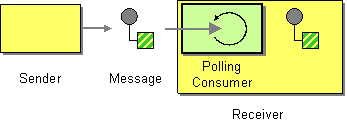Fuse 6 is no longer supported
As of February 2025, Red Hat Fuse 6 is no longer supported. If you are using Fuse 6, please upgrade to Red Hat build of Apache Camel.Ce contenu n'est pas disponible dans la langue sélectionnée.
10.3. Polling Consumer
Overview
Copier lienLien copié sur presse-papiers!
The polling consumer pattern, shown in Figure 10.2, “Polling Consumer Pattern”, is a pattern for implementing the consumer endpoint in a Apache Camel component, so it is only relevant to programmers who need to develop a custom component in Apache Camel. Existing components already have a consumer implementation pattern hard-wired into them.
Consumers that conform to this pattern expose polling methods,
receive(), receive(long timeout), and receiveNoWait() that return a new exchange object, if one is available from the monitored resource. A polling consumer implementation must provide its own thread pool to perform the polling.
For more details about this implementation pattern, see Section 47.1.3, “Consumer Patterns and Threading”, Chapter 50, Consumer Interface, and Section 46.2, “Using the Consumer Template”.
Figure 10.2. Polling Consumer Pattern
Scheduled poll consumer
Copier lienLien copié sur presse-papiers!
Many of the Apache Camel consumer endpoints employ a scheduled poll pattern to receive messages at the start of a route. That is, the endpoint appears to implement an event-driven consumer interface, but internally a scheduled poll is used to monitor a resource that provides the incoming messages for the endpoint.
See Section 50.2, “Implementing the Consumer Interface” for details of how to implement this pattern.
Quartz component
Copier lienLien copié sur presse-papiers!
You can use the quartz component to provide scheduled delivery of messages using the Quartz enterprise scheduler. See Quartz in the Apache Camel Component Reference Guide and Quartz Component for details.
